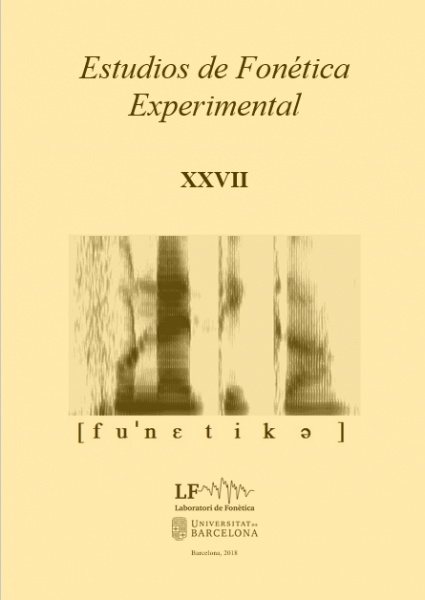Lenition of the segment /-d/ in the Spanish imperative
Keywords:
Spanish, phonetic variation, imperative, consonant lenition, voiced dental approximant, flapAbstract
In vernacular Spanish 2pp imperative forms (like cantad) are commonly replaced with the infinitive form of the verb (like cantar), although this is not accepted in the standard variety. This paper is a pilot study on the use of the infinitive instead of the imperative form. The main hypothesis that is that the form ending with a flap is the result of the reduction of /-d/, which reduces its length and this makes the imperative form coincide with the infinitive one. The results indicate that there are several degrees and forms of such reduction: voiced dental approximant, flap, voiced interdental fricative, trill and elision. In addition, it has been proven that the appearance of /-d/ and /ɹ/ is connected not only with the kind of word that follows the imperative, but also with the age of the speaker and with the phonological context. Additionally, the analysis of the data shows differences in the length of the differnts degrees or forms of reduction, which suggests the existence of a reduction in the duration of the consonant /-d/, which would also explain its potential interpretation as a flap.
References
BLECUA FALGUERAS, B. (2001): Las vibrantes del español: manifestaciones acústicas y procesos fonéticos, tesis doctoral, Universitat Autònoma de Barcelona.
BLECUA, B. (2005): «Variación acústica de la vibrante en posición implosiva», en Filología y lingüística: estudios ofrecidos a Antonio Quilis, Madrid, CSIC, Vol. 1, pp. 97-111.
BLECUA, B.; J. CICRES y J. GIL (2014): «Variación en las róticas del español y su implicación en la identificación del locutor», Revista de Filología Románica, 31, pp. 13-35.
BOERSMA, P. y D. WEENINK (2016): Praat: Doing phonetics by computer [programa informático]. Versión 6.0.14. http:// www.praat.org [03/02/2016]
GARCÍA MOUTON, P. e I. MOLINA MARTOS (2015): «La -/d/ en el atlas dialectal de madrid (ADiM): un cambio en marcha», Lapurdum, 19, pp. 277-299.
GARCÍA SANTOS, J. F. (2001): «Ni velarización ni interdentalización: lenición», en J. A. Bartol Hernández (coord.): Nuevas aportaciones al estudio de la lengua española: investigaciones filológicas, Salamanca, Luso- Española Ediciones, pp. 93-102.
HERNANZ CARBÓ, M. L. (1999), «El infinitivo», en I. Bosque y V. Demonte (eds.): Gramática descriptiva de la lengua española, Madrid, Espasa Calpe, Vol. 2, pp. 2338-2342.
KINGSTON, J. (2008): «Lenition», en L. Colantoni y J. Steele (eds.): 3rd Conference on Laboratory Approaches to Spanish Phonology, Somerville, Cascadilla Proceedings Project, pp. 1-31.
LINDBLOM, B. (1990): «Explaining phonetic variation: A sketch of the H and H theory», en W. J. Hardcastle y A. Marchal (eds.): Speech production and speech modelling, Dordrecht, Kluwer, pp. 403-439.
LORENZO, R. (1975): «El rotacismo en las lenguas románicas», Verba, 2, pp. 119-136.
MARTÍNEZ CELDRÁN, E. (1993): «Un mismo parámetro fonético en el fondo de la lenición protorromance: la duración», en J. A. Bartol Hernández, J. de Santiago Guervós, J. F. García Santos (eds.): Estudios filológicos en homenaje a Eugenio de Bustos Tovar, Vol. 2, pp. 621-640.
QUILIS, A. (1999): Tratado de fonología y fonética españolas, Madrid, Gredos.
RAE (2009): Nueva gramática de la lengua española: Sintaxis II, Madrid.
RAE (2011): Nueva gramática de la lengua española: fonética y fonología. Madrid.
ROST BAGUDANCH, A. (2016): «El extraño caso de la rótica infiltrada: reflexiones preliminares», en A. M. Fernández Planas (ed.), 53 reflexiones sobre aspectos de la fonética y otros temas de la lingüística, Barcelona: Laboratori de Fonètica de la Universitat de Barcelona, pp. 109-117.
SIMONET, M.; J. I. HUALDE. y M. NADEU (2012): «Lenition of /d/ in spontaneous Spanish and Catalan», Thirteenth Annual Conference of the International Speech Communication Association 2012 Inter Speech 2012, Vol. 2, pp. 1416-1419.
Downloads
Published
How to Cite
Issue
Section
License

This work is licensed under a Creative Commons Attribution-NonCommercial-NoDerivatives 4.0 International License.
All articles published online by Estudios de Fonética Experimental are licensed under Creative Commons Attribution-NonCommercial-NoDerivs 4.0 International (CC BY-NC-ND 4.0 DEED), unless otherwise noted. Estudios de Fonética Experimental is an open access journal. Estudios de Fonética Experimental is hosted by RCUB (Revistes Científiques de la Universitat de Barcelona), powered by Open Journal Systems (OJS) software. The copyright is not transferred to the journal: authors hold the copyright and publishing rights without restrictions. The author is free to use and distribute pre and post-prints versions of his/her article. However, preprint versions are regarded as a work-in-progress version used as internal communication with the authors, and we prefer to share postprint versions.




